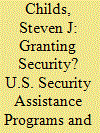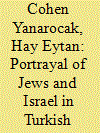| Srl | Item |
| 1 |
ID:
168850


|
|
|
|
|
| Summary/Abstract |
U.S. security assistance programs are expected to increase the capabilities of partners in the Middle East and Africa by leveraging the provision of armaments and training through foreign aid. Can policymakers increase their reliance on such programs to achieve foreign policy aims of promoting regional stability while retaining political flexibility? Using multivariate logistic regression of Middle East and African states spanning 1970 to 2015, the empirical findings suggest that U.S. programs geared toward education and training are more positively correlated with stability than programs oriented toward providing hardware.
|
|
|
|
|
|
|
|
|
|
|
|
|
|
|
|
| 2 |
ID:
168848


|
|
|
|
|
| Summary/Abstract |
The political fallout from the Arab spring and the growth of Salafism elsewhere have sparked a new debate about the merits of political Salafism. This article retraces the trajectory of political Salafism in Kenya between the early 1990s and the most recent elections in 2017. It focuses on two Salafi-led associations, the Council of Imams and Preachers in Kenya (CIPK) and the National Muslim Leaders Forum (NAMLEF). It notes two developments: first, the declining efficacy and relevancy of both organizations; and second, and as a result of the former, the inadvertent contribution of political Salafism to the radicalization of Kenya’s Muslim youth in Kenya’s coastal region. The study argues that both are an outcome of several interrelated factors, including the CIPK’s and NAMLEF’s involvement in partisan politics, the neo-patrimonial nature of Kenya’s political system, as well as the desire of the CIPK and NAMLEF leaderships to participate in that system and to generate high-ranking public appointments for themselves.
|
|
|
|
|
|
|
|
|
|
|
|
|
|
|
|
| 3 |
ID:
168849


|
|
|
|
|
| Summary/Abstract |
As the autobiographies of nations, the school textbooks’ portrayal of the “Other” is paramount for tackling prejudices and building bridges among nations. Using this idea as a guiding principle when witnessing the rising anti-Semitism and the anti-Israeli trends in Turkish society, this article examines the portrayal of Jews and the State of Israel in the Turkish school curriculum to reveal textbooks’ part in shaping the image of Jews and Israel in Turkey.
|
|
|
|
|
|
|
|
|
|
|
|
|
|
|
|